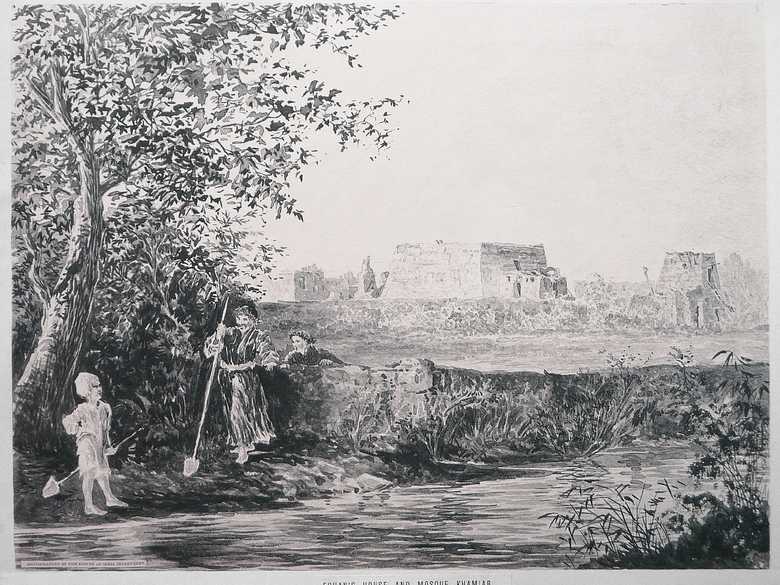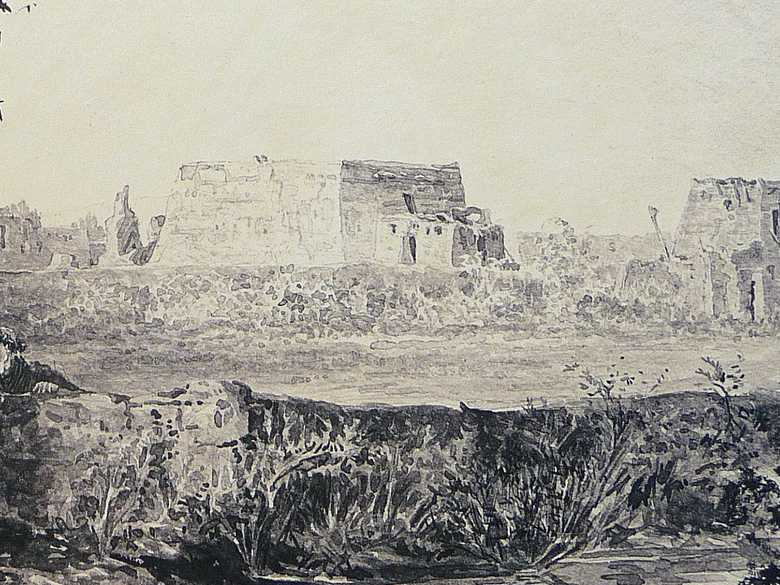ELD 093 — Mosque Khamiab
Sepia-toned photo-lithograph of a wash sketch, showing some flat-roofed Turkoman buildings in the typical conical shape. In the foreground a man and two boys beside a water canal, holding the specific small spade for opening and closing irrigation ditches.
Sepia-toned photo-lithograph of a wash sketch, showing some flat-roofed Turkoman buildings in the typical conical shape. In the foreground a man and two boys beside a water canal, holding the specific small spade for opening and closing irrigation ditches.
[Sketch, recto:] Photographed by the Survey of India Department. // ESHAN’S HOUSE AND MOSQUE KHAMIAB.
[Sketch, verso:] (71) / Eshan’s house & mosque Khamiab.
[Lumsden Album:] –
[List:] (83) “Eshan’s Priest’s” house and mosque at Khamiab.
[Sketch, verso:] (71) / Eshan’s house & mosque Khamiab.
[Lumsden Album:] –
[List:] (83) “Eshan’s Priest’s” house and mosque at Khamiab.
- Owen, Charles (1884-86): Transcript of diary and letters, p. 501: “20 Jun [1886] […] An Ishan or holy man objected to our going to new camp near here. Remains to be seen if he will give way. […]”
- Peacocke, W (1887): Records of Intelligence Party ABC, Vol. 3, pp. 97-100 (January 23, 1885): detailed description of the first ABC reconnaissance visit to Khamiab; p. 97: “The fields are enclosed by low mud walls, presumably to check the drift sand and to shelter the young trees, and are thickly planted with trees.”; “The houses are scattered about among the cultivation, and are not collected about any centres – a fact which betokens a freedom from dread of external danger. The entire district gives the impression of a thriving prosperity and a settled state of society living in a sense of peaceful security. (No alaman has visited this district since the time of Sher Ali).”; “Not a trace of dilapidation is to be seen. Even the enclosure walls of the fields are kept in good repair, and the sharpness of the angles and the copings of the walls, and the neat way in which they are repaired, form a contrast to the air of dilapidation presented by the buildings of Andkhui, Akcha, or Shibirghan. The trees are mainly mulberry and willow and smaller fruit trees. They are for the most part planted in regular lines, and at regular intervals in the fields, which all tends to give the impression of neat and systematic farming.”
- Yate, C.E. (1888): Northern Afghanistan or Letters from the Afghan Boundary Commission, pp. 226-230: stay at the camp in Khamiab; p. 244: “[…] His house is a long, square, flat-roofed mud-building, the walls of which are all built sloping slightly inwards, with no windows, only a door. There is sometimes a second storey, approached by a ladder, in which, I fancy, the silkworms are generally kept. These houses, though, are all empty at the present time. The Turkomans during the summer season live out in their kibitkas, pitched under the mulberry and other trees that surround the house. The fields are mostly enclosed by low mud-walls, and divided from each other by rows of willows and the pollard mulberries on which the silkworms are fed. Two or three fields distant from one mud-hut will be seen another, and so on all the way up. […]”
- Adamec, L.W. (1979): Mazar-i-Sharif and north-central Afghanistan, pp. 322-324: Khamiab or Kham Ab.
Bild Nr.
ELD 093
Sammlung
Afghan Boundary Commission 1884-86
Serie
ABC 5, ELD Sketches 054 to 107
Format
Original wash sketch, British Library WD 464, size 305/405 mmLithograph in the Lumsden Album 256/344 mm(84 % of original size)
Ort, Datum
Khamiab, June, 1886
Deskriptoren
Breitengrad / Längengrad37.530011 / 65.721875
Google Earth37°31ʹ47ʺ N / 65°43ʹ18ʺ E / 250 m
Google Mapshttps://maps.google.com
Zoom Earthhttps://zoom.earth
Survey of India MapSheet 32, Buchara (1929): Bosaga, 3 B
Sie wissen mehr zu diesem Bild?



